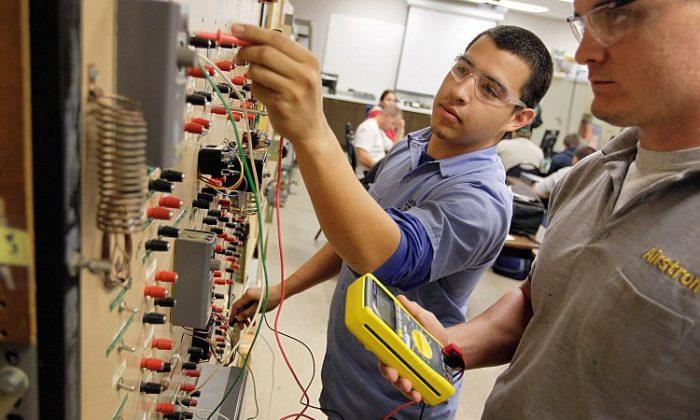It’s no secret that states compete with each other to attract “family wage” employers that provide health insurance and other benefits, especially in manufacturing and high-tech sectors.
The standard competitive toolboxes offered by state legislatures usually include tax credits, assorted regulatory waivers, and a host of other “fine print” incentives to induce corporations and businesses to invest in communities by building or expanding manufacturing plants, distribution centers, and administrative offices.
But as state lawmakers begin their 2023 sessions—45 legislatures will convene by Jan. 18—a tweak has emerged over the past decade in that interstate rivalry: competition in developing the workforces that high-wage industries need.
Federal Mix-and-Match Grants
Currently, because Congress approved $5.7 trillion in COVID-19 pandemic assistance bills between March 2020 and March 2021 and earmarked trillions more in economic stimulus packages by August 2022, there are billions of dollars in federal money on the table in the form of grants and other allocations that can be matched with state and local funds to steer to “workforce development.”The $1.9 trillion American Rescue Plan Act (ARPA), adopted in March 2021, provides more than $40 billion to “strengthen and expand” workforce development programs.
The $1.2 trillion Infrastructure Investment and Jobs Act (IIJA), adopted in November 2021, earmarks $800 million for “equitable workforce development” to build “the skilled, diverse talent pool” that employers seek.
The Inflation Reduction Act (IRA), adopted in August 2022, has at least $4.5 billion for workforce development. The Creating Helpful Incentives to Produce Semiconductors and Science (CHIPS) Act, passed that same month, includes $52.7 billion for semiconductor manufacturing, research and development, and “workforce development.”
How “workforce development” is being incorporated into economic development policies can vary from state to state and is, for the most part, an initiative with enthusiastic bipartisan support.
Tennessee, for instance, enticed Ford Motors to locate an electric vehicle manufacturing plant in the state by agreeing to build a Tennessee College of Applied Technology campus nearby, where students can get training for the high-paying, blue-collar manufacturing jobs it will provide.
Ford benefits by being able to craft a curriculum to ensure that the automaker gets the workforce it needs to actually operate the plant.
Pennsylvania, for instance, this week distributed $1.2 million for career and technical education centers with 33 applicants receiving money as part of a competitive grant program orchestrated by the state’s Department of Education in coordination with industry needs.
There are more than 80 career and technical centers in Pennsylvania—double the number in 2015—that offer classes and hands-on learning programs for industry-based credentials in fields ranging from construction and transportation to business management and health sciences.
The money must be used for “training students in high-demand occupations,” according to the Pennsylvania Department of Education. To qualify, applicants must match each proposed grant dollar-for-dollar with funds from a local source, such as local school funds or contributions from business and industry partners.
Pushing to ‘Compete With Neighboring States’
West Virginia state Del. John Paul Hott, a Republican, told The Epoch Times that in addition to tax policy and tort reform, when state lawmakers convene their 60-day 2023 session in Charleston, their common mission will be “to continue to position West Virginia to compete with neighboring states.”“We have made strides the last few sessions” in workforce development, he said, which is pivotal in putting the state in a “competitive position with job opportunities and low taxes, so [state residents] can work, live, raise a family in West Virginia.”
Georgia state Rep. Shaw Blackmon, a Republican, told The Epoch Times that Peach State lawmakers will focus “generally speaking” on “affordable housing, health care, tax cuts” amid “a push to look at electric vehicle situations” with “a lot of discussion over the course of the off-season in recruiting big industry here” by boosting the vocational substrate industry and high-tech environment that manufacturers need.
Arkansas state Rep. Aaron Pilkington, a Republican, told The Epoch Times that when state lawmakers convene their 60-day session in Little Rock on Jan. 9, “getting crime under control” will be among priorities, as will be “cranking out more economic development” by expanding vocational education programs that induce employers to the state.
Arkansas lawmakers will also be looking to funnel money into programs that “encourage more entrepreneurship,” he said.
“That is a big one.”

Money Talks, But Can’t Build a Bridge
The emphasis is welcomed by industry lobbyists, but more needs to be done, more quickly, especially in construction trades with states allocating billions of dollars in federal infrastructure money, Associated General Contractors of America (AGCA) spokesman Brian Turmail told The Epoch Times.“At the state and local levels, one thing [ACGA] is pushing lawmakers to do is make the needed investments in career and technical training programs,” he said. “There are a lot for high-paying careers available in construction.”
ACGA wants states “to make better use of community and technical colleges and to find ways to expand, define, and register apprentice shop programs so they can qualify for a lot of funding in the so-called Inflation Reduction Act,” Turmail said.
There’s momentum for this in state legislatures, but “most parts of the country don’t have training programs” unless they’re run by unions. he said.
With states awarding contracts for billions of dollars in infrastructure projects, contractors in many areas are finding it difficult to find qualified workers, Turmail said.
“At the local level, there needs to be greater investment and commitment [to trades training programs],“ he said. “The infrastructure money is not going to help so much if we don’t have people there to build it, if we’re not exposing people to career paths [in learning a trade].”
“Workforce deficiencies” from “‘the great resignation’” that unfolded in the wake of the pandemic have left “tons of openings” across a range of industries and “in construction at various levels; they can’t fill them fast enough,” American Society of Civil Engineers President Maria Lehman told The Epoch Times.
Developing a workforce trained in the construction trades “becomes critically important, especially within underrepresented classes—women, minorities. If you look across diverse populations, there is not a diverse population that is represented,” she said, noting that less than 23 percent of the nation’s construction workers are women or minorities.
“We have the need for people to get into these trades, going into schools, getting a welding certification or a commercial driver’s license” or earning two-year engineering technician and constriction project technician certifications, Lehman said.
The key is “rethinking how we do that with a different approach for different populations than in the past,” she said, noting that the nation is “85,000 engineers short” of what contractors say they need to build the roads and bridges on state drawing boards.
“That is a huge number. We’ve got to get creative,” Lehman said. “Those needs aren’t going away.”





